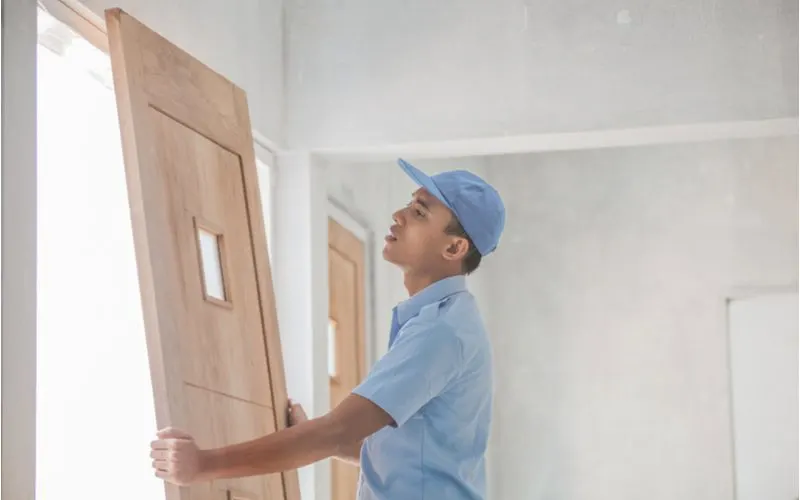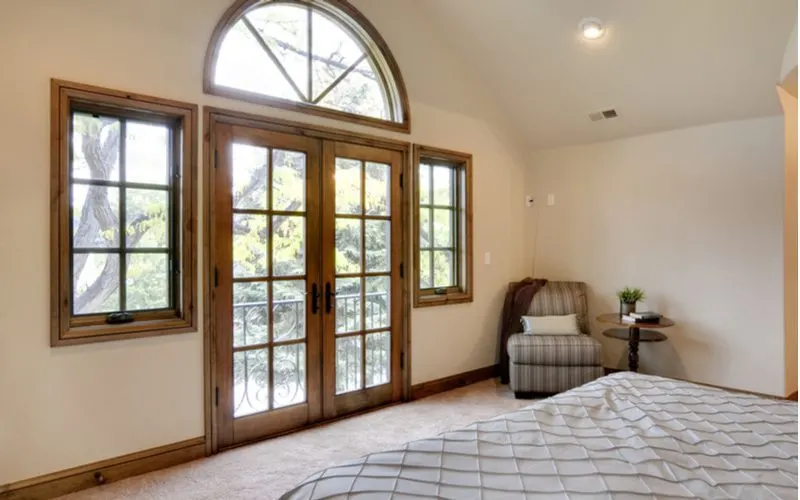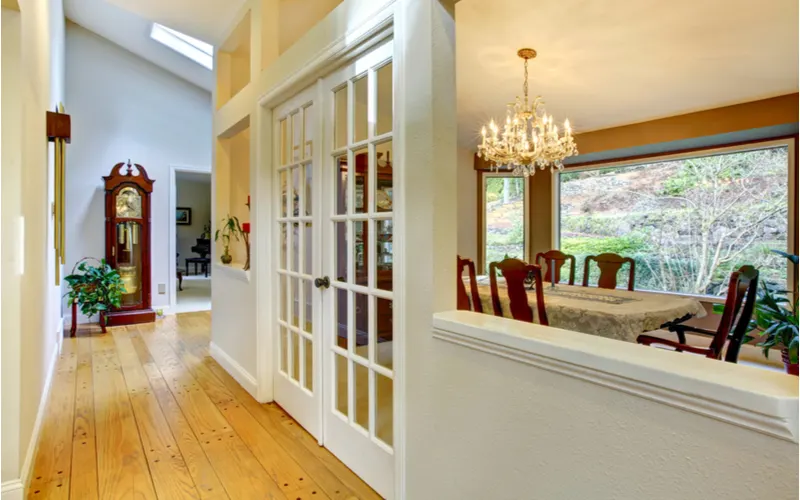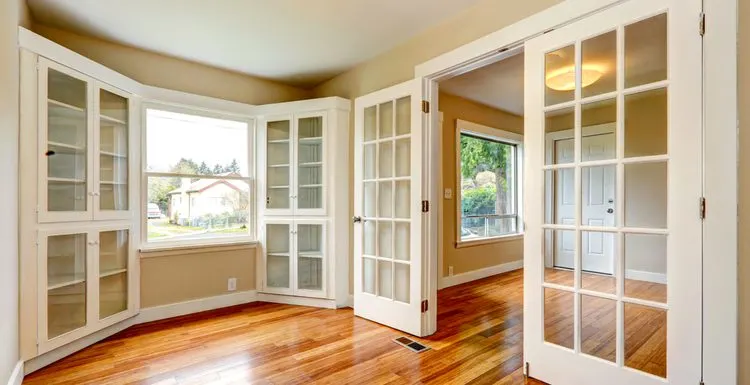Installing French doors is no easy task, and if that’s what you’re here for, you’re at the right place.
We’ll show you all you need to know about French door installation and its uses.
Read on to learn more.
A Summary Summary

Odua Images/Shutterstock
French doors allow natural light into the living areas and open up the home to the beautiful views of the outdoors.
This guide is to teach you everything about installing French doors by following a few quick and easy steps:
- Gather your equipment
- Prepare the opening
- Square the Opening
- Install pre-hung door
- Use a Shim
- Join the stud to the frame
- Make sure the frame is secure
How to Install French Doors
Step 1: Get your Tools and Materials
Installing French doors is no small task, and you’ll need some tools to get the job done.
These include:
- Pre-hung Doors
- Power drill
- Wood Shims
- Paddle bit
- Hammer
- Flat-head screwdriver
- Hole saw
- Measuring tape
- Crowbar
- Chisel
- Flush-cutting saw
- Carpenter’s square
- Safety glasses
- Torpedo level
- Long level
- Screws
- Nails
- Rubber mallet
- Door accessories (handles, latches and knobs)
Step 2: Prepare the Opening
Figure out how much space you need to install your doors. You’re most likely going to take off the drywall or make adjustments around the area.
However, you can safely take off the trim without doing damage to the wall by caulking around it.
Once you’re done with the caulk, pry it off with a crowbar. Once the trim is out of the way and you have sufficient drywall taken off, you can measure the width, making sure to mark the pieces to make it easy to put back up.
Step 3: Square the Opening
Get your long level and carpenter square. It’s best to have these tools to make sure your opening is square; otherwise, your door won’t align or close correctly.
Step 4: Install New Pre-Hung Doors
Take off the head and inside jambs; both are usually nailed together to make it easy to remove.
After that, slide the pre-hung French doors into the opening, ensuring the jambs are flush with the wall. You need to double-check that the doors can open in the direction you want without hindrance.
Step 5: Use a Shim
Use a shim on the jamb plumb to ensure the door is level and straight. Use as many shims as necessary under the side jambs until you’re sure the head jamb is level.
Step 6: Join Stud to Frame
Now you can nail your frame to the studs with #8 finishing nails, through the frame and shims until it’s in the studs. At this point, you can inspect the door to make sure everything is opening, shutting, and functioning correctly.
Step 7: Secure the Frame
Once you’re sure everything is in place, secure the frame and use a wood chisel or box cutter to smooth any exposed shims. You may decide to cut a new trim or reinstall the old trim as the project may require.
Now that you’re done, you can start to enjoy your newly installed French doors!
But if you have a bigger space to fill or want to turn it up a notch with your French doors, you’ll have to build and install a transom window for the door’s top.
Below is some helpful information to complete that DIY French door installation with a transom window.
How to Install French Doors With a Window Transom
Step 1: Continue From Step 7 above
First, continue from where you stopped in Step 6 of the guide above. Once your door is in place (excluding any top framing), measure the space above the door to see how many openings you can work with.
Note: Your window may have to be a quarter-inch smaller than the allowed space width and height to allow you to use shims to make it level and plumb.
Step 2: Prep Your Window
It’s up to you to decide the number of separate windows you want, whether two, three, or four, including the sides and the dividers needed to make each window.
For instance, if you prefer a window with three panels, you’ll need two separate partitions the same length as your sides. With 16-gauge finish nails and glue, you can start the construction of your window unit.
Step 3: Window Glass Molding
The next step is to figure out how your glass pane will fit into the window. For this guide, 3/4-inch molding works excellently well for the frame piece.
After you cut and measure the frame piece, use glue and 18-gauge brads for the insides of each part of the windowpane opening.
Step 4: Install Transom Window
The next step is the installation. Gently slide the window into the open space above the doors. Use a shim to edge it out in a few places before securing it with more 16-gauge nails.
Step 5: Beautify the Window
Now that you’ve installed the transom window, you can add decorative trim and door casing, including caulking every seam, and use wood filler for any nail holes you might find.
You can stain or paint the window, depending on the color or natural finish you’ve got in mind.
Step 6: Cut Your Glass
Decide how you want your class cut, whether by yourself or specially delivered from the hardware store.
However, since the window will be within 24 inches of an active door (the door that opens routinely), you need to temper the glass according to residential building codes.
That means cutting it yourself may be more than you can handle. Once you’ve received your 1/8-inch-thick tempered glass, the next step is to apply some caulk along the frame’s flat side and gently press the glass into place.
Step 7: Add Extra Trim Layer
It isn’t safe to leave the window as is. You’ll have to cut additional quarter-round trim to double up the first set of framing.
Take care to nail this new frame bit so that the glass isn’t only sandwiched stylishly but safely.
Step 8: Add Door Accessories
The final step for your fully functioning French doors is to install any other accessory or hardware like a ball catcher and brackets that prevent the door from wiggling when you close, including knobs and door handles of your choice.
Congratulations! You’re done!
Things to Consider

Ambient Ideas/Shutterstock
Below are things to consider before, during, or after learning how to install French doors:
- Consider getting an exterior French door if you need access to the outdoors, like the balcony, garden, patio, or verandah.
- Purchase an interior French door if you want a divider between connected rooms. It’s also possible to use a French door in other locations, like the bathroom.
- French doors are expensive, sometimes even costing several thousand dollars.
- French doors don’t only come as a set of double doors. You can find French doors as bifold, single, or sliding doors.
- If you plan to sell your home in the future, purchasing premium-quality French doors will add value to your home.
- You may need to pay for a permit before installation.
- It’s possible to use a screen with your French door, with the two options available being magnetic and retractable screens.
- If you emphasize security, get a French door with a three-point living system.
- Always consider the door swing. French doors have the option of an in-swing or an out-swing, so choose wisely.
- Don’t install your French doors without measuring the swing radius, and make sure there’s no furniture within the swing of the door.
- For patio or deck access, purchase entry French doors.
- Before purchasing a French door, make sure you know the material, glass, window type, and overall color and size.
- Don’t forget the glass. If your doors get a lot of sunlight, you’d need to consider going for coated or tinted options to prevent art, furniture, or floors from fading.
- Consider opaque or dark doors for situations where you need light and privacy.
- For exterior French doors, use Low-E or double-paned glass that uses heat-reflective material for the best insulation.
- Consider making your exterior French doors weather-proof by fitting them with weather stripping to protect them from the elements.
- It would help if you considered taking door measurements. Standard-sized doors can easily take in prehung French doors. However, older houses may require custom fittings. We recommend talking to an expert.
- Old French doors may have a seductive appeal, but consider buying new doors for exterior use because of the better security, durability, and insulation these doors provide.
- French doors are expensive to keep in excellent condition. You can buy one if it isn’t a hassle for you to maintain.
How Do You Install a French Door?

Artazum/Shutterstock
So there you have it—our guide to installing French doors. As stated above, it is crucial to inspect the swing radius to make sure there’s nothing in the door path.
Your next step is to measure the jamb depth of the opening and buy a door that will fit inside the jamb. If your home is new, it will be easy to install a regular-sized French door.
Older homes may need more work because they often come with non-standard openings.
No matter what type of French doors you get, ensure you follow the instructions provided by the manufacturer.

